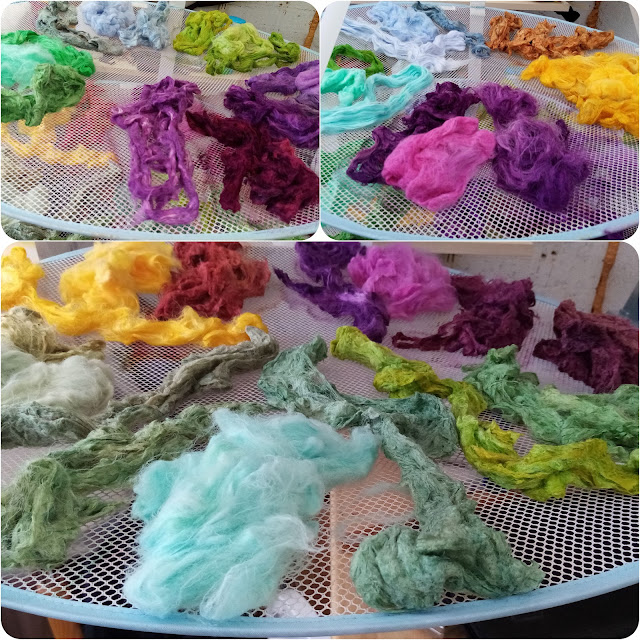So, onto my analysis of my first attempt at dyeing plant based and cellulose based fibres. The two anomalies that were pretty obvious were with the Tropical Green and the Deep Violet dyes.
Although not all of the fibres dyed 100% Tropical Green turned out to be anything like the expected colour, I am not going to over-dye what I did get from it because I do like the final result. I've put together a kind of results photo of just the 100% Tropical Green fibres to show the comparison of fibres. Some of them turned out more pale blue or aqua than green. They are pretty though and I don't really mind as these were dyed purely to add a variety of colours to my "ingredients cupboard" for when I make blends with wool. I wasn't dying with a specific end result in mind.
I over-dyed the disappointing result from dyeing the Faux Cashmere/Bio-Nylon blend and the Trilobal Nylon using my usual Greener Shades Dyes at 1% depth in Coral Reef Aqua. I have discovered that these two Nylon based fibres can be dyed with either dye, both work on these particular fibres.
 |
Top: Faux Cashemere/Bio-Nylon before & after
Bottom: Trilobal Nylon before & after |
As I already said in the previous post, I did re-dye all of the Soybean again but on their own in the dye pot.
Summary by fibre type
Hemp - all of the samples dyed a little patchy so I think I need to open up the fibres more before putting them in the dye pot. Having said that they did all come out the expected colour or close to it.
Trilobal Nylon - all of the samples dyed pretty evenly except for one and there was the two anomalies, being the Tropical Green and the Deep Violet.
Ingeo Corn - both samples dyed evenly and beautifully and the blue dyed as expected, it was the one that went into the green dye that didn't dye green.
Himalayan Nettle - both samples dyed a little patchy, I probably needed to open the fibres out a bit more, but took dye well and exactly the colour expected.
Pearl Fibre - both samples dyed a little patchy but intensely and the colour expected.
Soybean/Soy Silk - all of the samples dyed quite patchy, which was probably my fault for not opening the fibres up more than I did. I re-dyed them in the same colours but opened them up more and gave them the entire dye pot to move around in and they came out much better.
Pineapple Fibre - both samples took the dye well, although a little patchy, and the colour was as expected.
Egyptian Cotton - this took the dye well and the colour was as expected. I should have opened the fibres out more as it was a little patchy, especially in the centre of the length.
Faux Cashmere/Bio-Nylon blend - all samples took the dye well and evenly and the colour as expected except for the Deep Violet and the Tropical Green.
Milk Protein - both samples took the dye well and evenly. The blue was as expected and the green was a lot brighter/more vivid than expected.
Banana Fibre - both samples dyed patchy so I need to make sure I really open the fibres if I do this again but they did dye intensely.
Mint Fibre - this had a pale golden base colour and I did only dye both samples a very subtle colour but they are both very slightly patchy and not dyed evenly.
Rose Fibre - both samples took the dye vibrantly although slightly patchy.
Over-dyed Soy Silk - both samples took the dye well but not evenly but this is most likely because the original colour was not a solid colour either, it was light and dark shades of pink.
I do have more fibres of this kind that I want to dye once I have purchased more colours to give me a larger range of colours that I can get from these dyes.














































